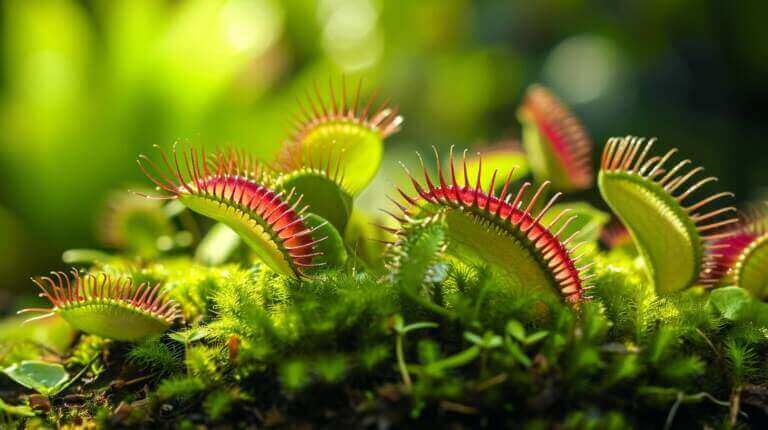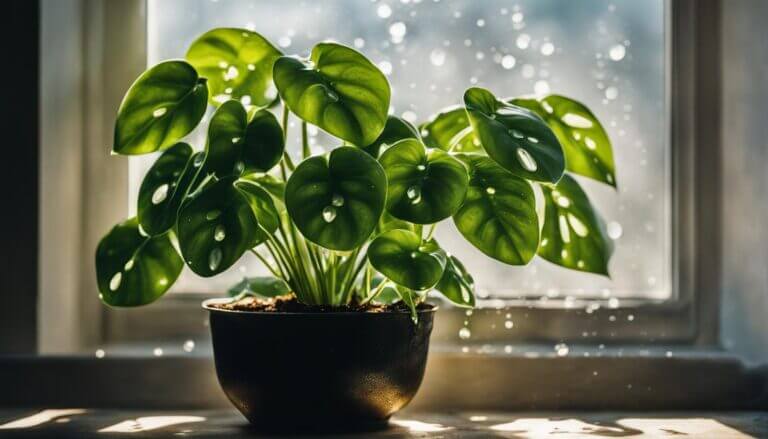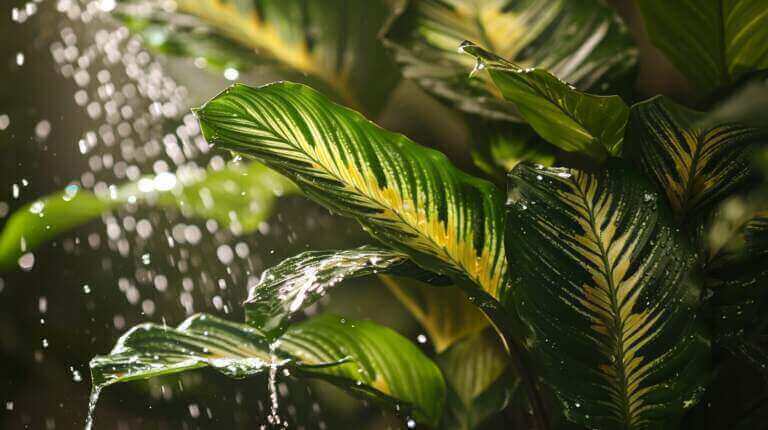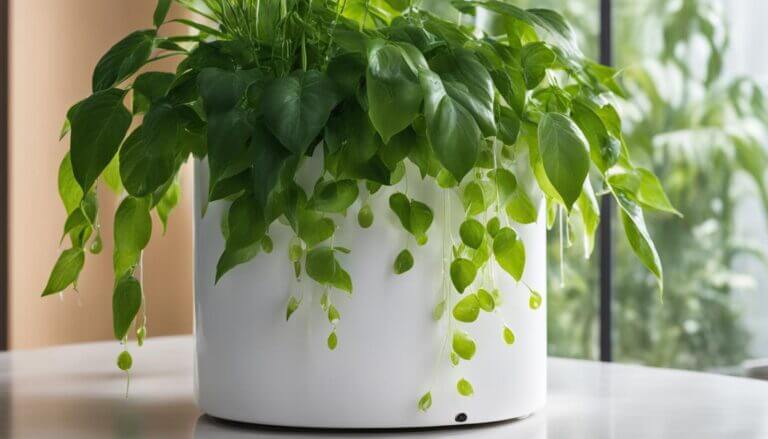Achieving the Perfect Watering Routine for Your String of Pearls Succulent(Senecio Rowleyanus)
String of pearls or string of beads, also known as Senecio rowleyanus, is a unique succulent plant that features cascading stems of small, bead-like leaves. To maintain this plant’s health and prevent overwatering, it is important to establish a proper watering routine during the growing season. Establishing a proper watering routine during the growing season is crucial for the health and vitality of your string of pearls, ensuring it effectively stores water. The key to watering string of pearls is to allow the soil to dry out slightly between waterings. This indoor plant is adapted to store water in its bead-like leaves, so it is important not to let the soil remain soggy for extended periods of time.
Key Takeaways:
- Establishing a proper watering routine during the growing season is crucial for the health and vitality of your string of pearls, ensuring it effectively stores water.
- String of pearls can be grown both indoors and outdoors, depending on your climate.
- It is important to keep string of pearls out of reach of pets and children due to its toxic nature.
- Ensure your string of pearls receives bright, indirect sunlight and is watered sparingly.
- Common issues with string of pearls include overwatering, sunburn, pests, and root rot.
Should You Grow String of Pearls Indoors or Outdoors?
String of pearls is a succulent, you have the option to cultivate this stunning succulent both indoors and outdoors. The decision between the two largely depends on your climate and the specific conditions in your living space. Let’s explore the pros and cons of each option to help you make an informed choice for your string of pearls plant care.
String of Pearls Indoors
Growing string of pearls indoors is a popular choice, especially for those living in colder climates. This allows you to enjoy the beauty of this unique plant year-round, regardless of the weather outside. Indoor cultivation also provides greater control over the plant’s environment, including temperature, humidity, and light exposure.
- Keep your string of pearls near a window that receives bright, indirect sunlight. An east-facing window is often the ideal spot.
- Ensure the plant is placed in a well-draining potting mix specifically formulated for succulents.
- Water your string of pearls sparingly, allowing the soil to dry out between waterings to prevent root rot.
- Monitor the plant for signs of pests, such as mealybugs, and take appropriate measures to control them.
String of Pearls Outdoors
For those lucky enough to live in warmer climates, growing string of pearls outdoors can be a great option. This allows the plant to thrive in its natural habitat, benefiting from more sunlight and outdoor air circulation. However, it’s important to provide the right conditions to protect the plant from excessive heat and direct sunlight.
| Pros | Cons |
|---|---|
| More sunlight exposure for the plant | Potentially harsh weather conditions |
| Natural outdoor air circulation | Increased risk of pests and diseases |
| Plant growth can be more vigorous | Requires maintenance and protection during extreme temperatures |
Whether you choose to grow your string of pearls indoors or outdoors, proper care is key to its success. Understanding the unique needs of this plant and providing it with the right growing conditions will ensure that it thrives and adds a touch of natural beauty to your living space.
Is String of Pearls Toxic?
When caring for your string of pearls plant, it’s important to be aware that it is toxic to both humans and pets. Accidental ingestion of any part of the plant can lead to skin irritation, gastrointestinal symptoms, and discomfort. To ensure the safety of your loved ones, it’s recommended to keep the string of pearls out of reach of pets and children. Additionally, when handling the plant, it’s advisable to wear gloves to avoid any adverse reactions.
String of pearls contains toxic substances known as glycosides, which can cause issues if ingested. Some of the symptoms that can occur include nausea, vomiting, diarrhea, and allergic reactions. If you suspect that someone has ingested the plant or is experiencing any adverse effects, it’s essential to seek medical attention immediately.
To enjoy the beauty of the string of pearls without putting anyone at risk, it’s crucial to take the necessary precautions. Keep the plant in a safe and secure location, away from curious pets and small children. By being aware of its toxic nature and taking appropriate measures, you can continue to enjoy the unique and captivating presence of the string of pearls in your home or garden.
General Care for String of Pearls
Proper care is essential for the health and vitality of your string of pearls plant. In this section, I will provide you with valuable information on light requirements, watering frequency, soil type, humidity, and propagation tips.
Light Requirements
String of pearls thrives in bright, indirect sunlight. Whether you choose to grow it indoors or outdoors, make sure the plant receives about 6 to 8 hours of sunlight per day. Place it near a window with eastern or western exposure to provide the optimal lighting conditions.
Watering Frequency
When it comes to watering your string of pearls, it’s important to strike the right balance. Overwatering can lead to root rot and other issues, while underwatering can cause the plant to wither. Allow the soil to dry out completely between waterings and water sparingly. As a general rule, water your string of pearls about once every two weeks, adjusting the frequency based on the moisture level of the soil.
Soil Type and Humidity
String of pearls requires well-draining soil to prevent waterlogged roots. Use a mixture of regular potting soil and perlite or pumice to ensure proper drainage. Avoid using heavy, moisture-retaining soil. Additionally, string of pearls prefers a dry environment and does not require high humidity. Extra humidity is not necessary for this plant.
Propagation Tips
String of pearls can be propagated easily through stem cuttings. Simply take a healthy cutting with at least three leaf nodes and allow it to callous for a few days. Once calloused, plant the cutting in well-draining soil or place it in a container of water. Keep the soil moist but not wet until roots develop. After the roots are established, you can pot the new plant in its own container.
| Light Requirements | Watering Frequency | Soil Type | Humidity | Propagation |
|---|---|---|---|---|
| Bright, indirect sunlight | About once every two weeks | Well-draining soil with perlite or pumice | Does not require high humidity | Propagation through stem cuttings |
Troubleshooting Common Problems with String of Pearls
String of pearls, like any plant, can encounter several issues that may affect its health and appearance. Understanding and addressing these problems promptly will help ensure the well-being of your string of pearls plant. Here are some common problems you may encounter:
Overwatering
One of the most common problems with string of pearls is overwatering. This plant is highly sensitive to excess moisture, and soggy soil can lead to root rot and other issues. Signs of overwatering include yellowing leaves and mushy stems. To resolve this problem, adjust your watering frequency and allow the soil to dry out between waterings. Remember, it’s better to underwater than to overwater your string of pearls.
Sunburn
String of pearls prefers bright, indirect sunlight. However, intense sunlight can lead to sunburn. Signs of sunburn include brown or white patches on the leaves. If your plant is experiencing sunburn, move it to a location with less direct sunlight or provide some shade during the hottest parts of the day.
Pests
Mealybugs are a common pest that can affect string of pearls plants. These small, white insects feed on the sap of the plant and can cause damage if left untreated. If you notice tiny cotton-like clusters on the leaves or stems, it’s likely that your plant is infested with mealybugs. To get rid of them, you can use a cotton swab dipped in rubbing alcohol to remove them or apply insecticidal soap. Regularly inspect your plant for any signs of pests and take action immediately to prevent infestations from spreading.
Poorly Draining Soil
String of pearls thrives in well-draining soil. If the soil is not allowing excess water to escape, it can lead to root rot and other problems. Make sure you’re using a well-draining soil mix specifically designed for succulents. If your plant is in a container, ensure that it has drainage holes at the bottom to allow water to flow out freely.
| Problem | Symptoms | Solutions |
|---|---|---|
| Overwatering | Yellowing leaves, mushy stems | Adjust watering frequency, allow soil to dry out between waterings |
| Sunburn | Brown or white patches on leaves | Move plant to a location with less direct sunlight or provide shade |
| Pests (mealybugs) | Tiny cotton-like clusters on leaves or stems | Remove mealybugs with rubbing alcohol or use insecticidal soap |
| Poorly Draining Soil | Root rot, waterlogged soil | Use well-draining succulent soil mix, ensure container has drainage holes |
How To Propagate String Of Pearls Succulent(Senecio Rowleyanus)
String of pearls are easy to propagate to grow new plants and expand your collection. By following a few simple steps, you can successfully propagate string of pearls and enjoy the beauty of these unique succulents. Here are some propagation tips to help you get started:
- Take stem cuttings: To propagate string of pearls, carefully take stem cuttings from a healthy plant. Look for long, trailing stems with multiple sets of leaves. Cut the stems using clean, sharp scissors or pruning shears.
- Allow the cuttings to callous: After taking the cuttings, allow them to dry and callous for a few days. This helps prevent rotting and promotes root development.
- Root the cuttings: Once the cuttings have calloused, you can root them in either well-draining soil or water. If rooting in soil, use a succulent or cactus potting mix and gently insert the cut end of the stem into the soil. If rooting in water, place the cut end of the stem in a glass or jar filled with filtered or distilled water.
- Provide optimal conditions: Regardless of whether you choose soil or water propagation, it’s important to provide optimal conditions for the cuttings to root. Place the cuttings in a bright location with indirect sunlight. Avoid direct sun exposure, as it can scorch the delicate leaves.
- Maintain proper moisture: While propagating string of pearls, it’s crucial to maintain proper moisture levels. For soil propagation, lightly mist the soil to keep it slightly moist but not overly wet. For water propagation, change the water every few days to prevent stagnation and bacterial growth.
- Be patient: Rooting and establishing new plants takes time, so be patient and allow the cuttings to develop roots. It can take several weeks or even a few months for the cuttings to root and produce new growth.
| Propagation Method | Advantages | Disadvantages |
|---|---|---|
| Soil propagation |
|
|
| Water propagation |
|
|
Proper Watering Techniques for String of Pearls
Watering your string of pearls correctly is essential for its overall health and well-being. In this section, I will guide you through the proper watering techniques to ensure that your plant thrives and remains beautiful. Following these guidelines will help prevent overwatering and keep your string of pearls looking its best.
Watering Schedule
String of pearls should be watered sparingly, approximately once every two weeks. This succulent plant has adapted to survive in arid conditions, so it is important not to overwater. Before watering, check the soil moisture by inserting your finger about half an inch deep into the soil. If the soil feels dry to the touch, it’s time to water your string of pearls. However, if the soil still feels slightly damp, it is best to wait a few more days before watering again.
How to Water My String of Pearls
When watering your string of pearls, it is important to water thoroughly but avoid soaking the soil. Use a watering can with a fine spout or a spray bottle to distribute water evenly across the soil surface. Aim to water the soil directly and avoid getting water on the leaves or trailing stems, as excess moisture can lead to rot and other issues. Allow the water to soak into the soil and drain out through the bottom of the pot. Discard any excess water that collects in the saucer or tray beneath the pot to prevent waterlogged roots.
Winter Watering
During the winter months, string of pearls enters a period of dormancy and requires less frequent watering. Reduce the watering frequency to approximately once a month, as the plant’s growth slows down during this time. It is important to monitor the soil moisture during winter and adjust the watering schedule accordingly. Remember, it is always better to underwater than to overwater your string of pearls, as it is more forgiving of drought-like conditions than excessive moisture.
| Signs of Overwatering | Prevention and Solution |
|---|---|
| Yellowing leaves | Reduce watering frequency and ensure proper drainage |
| Mushy stems | Allow soil to dry out before watering again |
| Root rot | Ensure well-draining soil and proper watering techniques |
FAQ
What is the perfect watering routine for my string of pearls?
String of pearls should be watered sparingly, allowing the soil to dry out between waterings. Check the soil moisture before watering and ensure it is dry to the touch for at least half an inch. During the dormant winter months, watering frequency should be reduced to about once a month.
Should I grow my string of pearls indoors or outdoors?
String of pearls can thrive both indoors and outdoors. In warmer climates, it can be grown outdoors in partially shaded areas. In cooler zones, it is best to keep it in a container and bring it indoors for protection.
Is string of pearls indoor plant toxic?
Yes, string of pearls is toxic to humans and pets. Accidental ingestion can cause skin irritation and gastrointestinal symptoms. It is important to keep it out of reach of pets and children and to handle it with gloves.
How often should I water my String of Pearls plant?
The watering frequency for a String of Pearls plant depends on the environment. In a hot, dry climate, you might need to water it once a week. In a cooler, humid environment, every two weeks or even once a month might be enough.
What does a healthy String of beads look like?
A healthy String of Pearls plant has plump, round beads that are evenly spaced along a thin, string-like stem. The color should be a vibrant green.
How do I get my String of Pearls to bloom?
To encourage your String of Pearls to bloom, provide it with plenty of indirect light and keep it in a cooler environment during the winter months. Blooms typically appear in the late winter or early spring.







